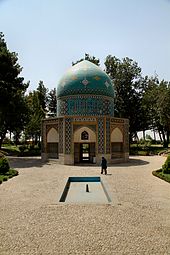Nishapur
Nishapur or Neyshābūr, also Romanized as Nīshāpūr, Nīshābūr, and Neyshābūr from Middle Persian: New-Shabuhr, meaning "New City of Shapur", "Fair Shapur", or "Perfect built of Shapur"), is a city in the w:Razavi Khorasan Province, capital of the Nishapur County and former capital of Khorasan, in northeastern Iran, situated in a fertile plain at the foot of the Mount Binalud. It had an estimated population of 239,185 as of 2011 and its county 433,105. Nearby are the turquoise mines that supplied the world with turquoise for at least two millennia.


The city was founded in the 3rd century by Shapur I as a Sasanian satrapy capital. Nishapur later became the capital of the Tahirid dynasty and was reformed by Abdullah Tahir in 830, and was later selected as the capital of the Seljuq dynasty by Tughril in 1037. From the Abbasid era to the Mongol invasion of Khwarezmia and Eastern Iran, the city evolved into a significant cultural, commercial, and intellectual center within the Islamic world. Nishapur, along with Merv, Herat and Balkh were one of the four great cities of Greater Khorasan and one of the greatest cities in the middle ages, a seat of governmental power in eastern of caliphate, a dwelling place for diverse ethnic and religious groups, a trading stop on commercial routes from Transoxiana and China, Iraq and Egypt. The city reached the height of its prosperity under the Samanids in the 10th century, but was destroyed by Mongols in 1221, and further ruined by other invasions and earthquakes in the 13th century.
| This geography-related article is a stub. You can help out with Wikiquote by expanding it! |
Quotes
edit- Nishapur is the best cities of the Great Khorasan.
- Attributed to Muhammad by al-Hakim al-Nishapuri
- One can not decide which one of the notables of this city he should talk about.
- Scimitars from Nishapur, along whose captured arcs there seemed to persist still the wind and violence of battle.
- Jorge Luis Borges, The Shape of the Sword